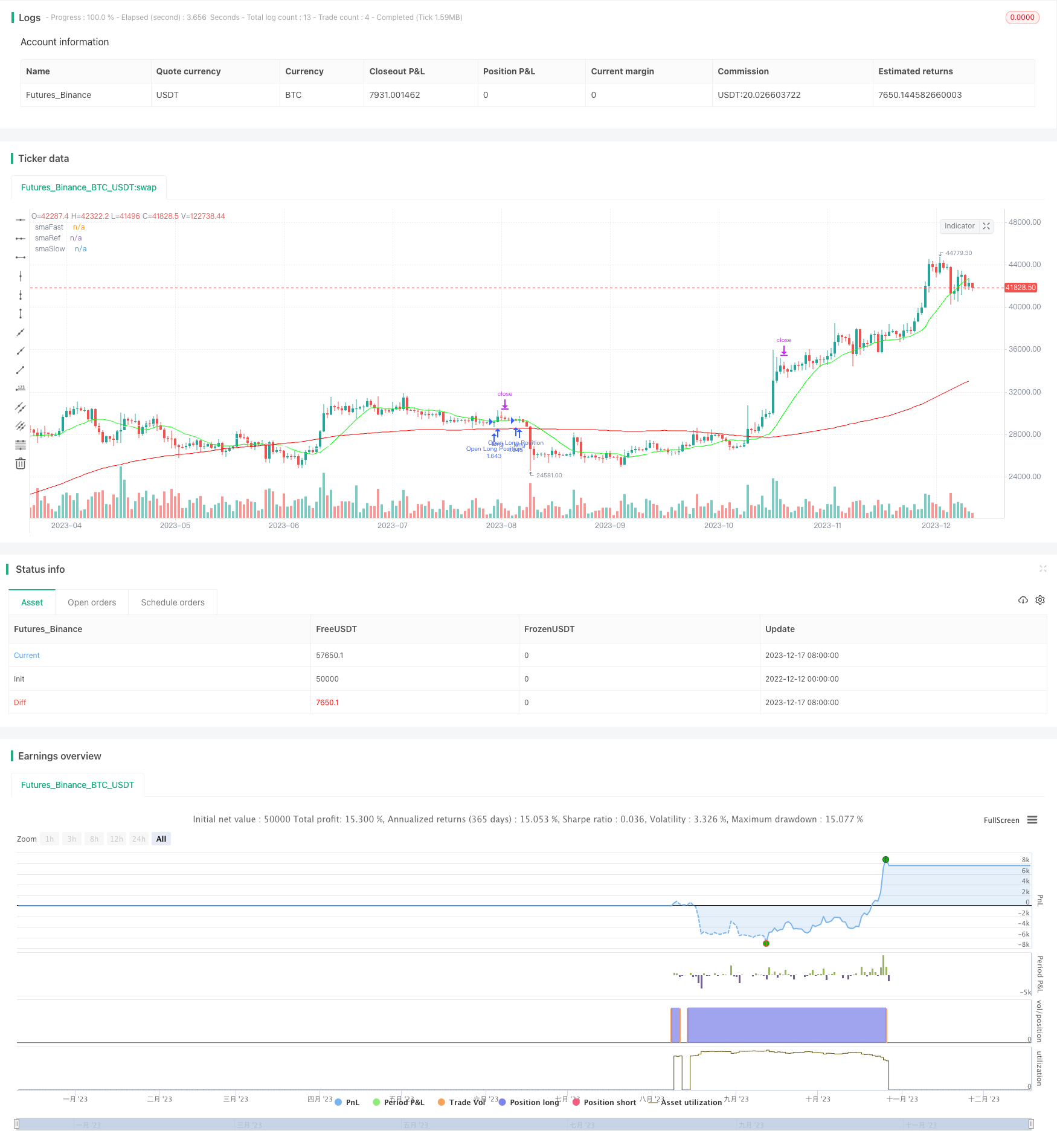
SMA 변동성 편차 거래 전략
전략 개요
이 전략은 간단한 이동 평균과 몇 가지 수학 계산을 사용하여 구매/판매 지점을 결정한다. 우리는 100 일 SMA를 기준선으로 사용합니다. 종결 가격이 그 선보다 낮다면, 우리는 그 선보다 낮은 위치에 따라 개시 지점을 선택합니다.
전략 원칙
이 전략은 세 개의 SMA 라인을 사용한다: 빠른 라인 (기본 14일), 느린 라인 (기본 100일) 및 참조 라인 (기본 30일).
마감값이 기준선보다 낮고, 느린 선에 대한 낮은 편차가 구성된 낮은 편차보다 크며, 빠른 선이 올라가고 느린 선이 내려가면, 다단으로 진입한다. 이러한 조건이 충족될 때, 빠른 선과 느린 선이 교차할 가능성이 매우 높기 때문에 더 좋은 진입점이다.
닫기 가격이 참조선보다 높고, 느린 선에 대한 높은 편차가 구성된 높은 편차보다 크면, 닫기 가격이 연속으로 3개의 K선으로 상승하여 수익을 달성하고, 빠른 선이 느린 선보다 높을 때, 평점 포지션은 단순하다. 가격이 계속 크게 상승하면, 추적 스톱 손실이 시작된다.
매 거래의 포지션은 특정 비율에 따라 진입하여 포지션을 제어합니다.
전략적 강점 분석
- SMA의 장점을 활용하여 가격 곡선을 평평하게 하고 시장 소음을 필터링하십시오.
- SMA 크로스에는 트렌드를 예측할 수 있는 능력이 있다.
- SMA 라인에 대한 편차를 설정하여 가짜 돌파를 피하십시오.
- 트렌드와 크로스 지표와 결합하여 의사 결정의 정확성을 향상시킵니다.
- 이 경우, 상환을 피하기 위해 손실 추적을 사용하여 수익을 고정합니다.
전략적 위험 분석
- SMA 자체는 지연성이 강하여 가격 전환점을 놓칠 수 있습니다.
- 오차량 설정이 잘못되면 과격하거나 과민하게 조심할 수 있습니다.
- 추적 스톱 패러미터를 잘못 설정하면 너무 일찍 또는 너무 큰 스톱 패러미터가 발생할 수 있습니다.
- 가격의 급격한 변동에 대처할 수 없는 시장
대응 최적화 조치:
- 다른 선행 지표와 함께 필터링
- 오차량에 대한 반복 테스트 최적화.
- 스피드 패러미터를 반복적으로 재검토하여 최적의 패러미터를 찾는다.
- 높은 변동성 시점에 지위를 낮추십시오.
전략 최적화 방향
- 다른 주기의 SMA를 테스트하여 최적의 변수를 찾습니다.
- 시장 구조와 동향을 판단하는 다른 지표에 추가
- 더 많은 수익을 위해 스톱 손실 변수를 최적화 추적
- 시장의 변동에 따라 포지션을 조정합니다.
- 동시에 여러 품종에 적용되고 조합된다.
요약하다
SMA 파동 편향 거래 전략은 편향량을 다른 SMA 평균을 참조하여 최적의 입문 시점을 찾습니다. 또한, 탈퇴 메커니즘은 손실을 추적하여 수익을 고정합니다. 이 전략은 간단하고 이해하기 쉽고 실행이 쉽습니다.
전략 소스 코드
/*backtest
start: 2022-12-12 00:00:00
end: 2023-12-18 00:00:00
period: 1d
basePeriod: 1h
exchanges: [{"eid":"Futures_Binance","currency":"BTC_USDT"}]
*/
// @version=4
// Author: Sonny Parlin (highschool dropout)
strategy(shorttitle="SMA+Strategy", title="SMA Offset Strategy",
overlay=true, currency=currency.USD,
initial_capital=10000)
// Inputs and variables
ss = input(14, minval=10, maxval=50, title="SMA Fast (days)")
ff = input(100, minval=55, maxval=200, title="SMA Slow (days)")
ref = input(30, minval=20, maxval=50, title="SMA Reference (days)")
lowOffset = input(0.001, "Low Offset (%)", minval=0, step=0.001)
highOffset = input(0.0164, "High Offset (%)", minval=0, step=0.0001)
orderStake = input(0.96, "Order Stake (%)", minval=0, step=0.01)
// SMA
smaFast = sma(close, ss)
smaSlow = sma(close, ff)
smaRef = sma(close, ref)
distanceLow = (close - smaSlow) / close
distanceHigh = (close - smaSlow) / close
// Set up SMA plot but don't show by default
plot(smaFast, "smaFast", color=#00ff00, display = 0)
plot(smaSlow, "smaSlow", color=#ff0000, display = 0)
plot(smaRef, "smaRef", color=#ffffff, display = 0)
// The buy stratey:
// guard that the low is under our sma low reference line by our lowOffset %,
// default is 0.001. (low < smaRef) and (distanceLow > lowOffset)
// SMA fast is on the rise and SMA slow is falling and they are very likely
// to cross. (rising(smaFast,1)) and (falling(smaSlow, 1))
enterLong = (low < smaRef) and (distanceLow > lowOffset) and (rising(smaFast,1)) and (falling(smaSlow, 1))
// The sell Strategy:
// Guard that close is higher than our sma high reference line by our
// highOffset %, default is 0.0164. (close > smaRef) and (distanceHigh > highOffset)
// Guard that close has risen by 3 candles in a row (rising(close,3))
// Guard that we currently have profit (strategy.openprofit > 0)
// Guard that SMA fast is higher than smaSlow (smaFast > smaSlow)
// If it keeps going up past our close position the trailing stoploss will kick in!
enterShort = (close > smaRef) and (distanceHigh > highOffset) and (rising(close,3)) and (strategy.openprofit > 0) and (smaFast > smaSlow)
// Order size is based on total equity
// Example 1:
// startingEquity = 2000
// close = 47434.93
// orderStake = 0.45
// (2,000 × orderStake) / close = orderSize = 0.0189733599 = approx $900
// Example 2:
// startingEquity = 2000
// close = 1.272
// orderStake = 0.45
// (startingEquity × orderStake) / close = orderSize = 707.5471698113 = approx $900
orderSize = (strategy.equity * orderStake) / close
// Trailing Stoploss
// I'm using 1.35 as my default value, play with this for different results.
longTrailPerc = input(title="Trailing Stoploss (%)",
type=input.float, minval=0.0, step=0.1, defval=1.35) * 0.01
longStopPrice = 0.0
longStopPrice := if (strategy.position_size > 0)
stopValue = close * (1 - longTrailPerc)
max(stopValue, longStopPrice[1])
else
0
if (enterLong)
strategy.entry("Open Long Position", strategy.long, orderSize, when=strategy.position_size <= 0)
if (enterShort)
strategy.exit(id="Close Long Position", stop=longStopPrice)
//plot(strategy.equity)